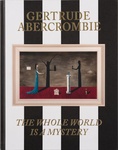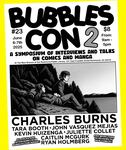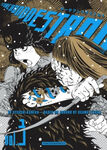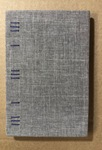
2011 marked the culmination of a decades-spanning career arc as Frank Santoro found his art at the center of the 2011 Pittsburgh Biennial at The Carnegie Museum of Art, where he attended studio art classes as a youth. We are excited to at last be able to offer for sale copies of his 16-page tabloid newspaper comics work that was the highlight of that exhibit. In a signature Santoro move, Blast Furnace Funnies is a work of "High" (i.e., museum quality) art executed in the lowest of the "Low" art forms (a disposable newspaper); employing ephemerality to evoke eternity, he has here worked (in a form that often ends up) in the gutter to reach for the stars. The originals for all 16 pages of Blast Furnace Funnies were exhibited at The Carnegie alongside of a giant stack of the newspapers we're offering here, and they really stood out on the walls for the wide tonal range displayed on each page; from wispy grays to solid blacks, from strong straight lines to streaks, curves, scribbles and blurs, each page contained marks made to match the mood. The color scheme of the newspaper itself is a duo-tone of varying saturations, consisting of yellow and magenta, that yields a surprising variety of hues, suggested and actual. The message that Blast Furnace Funnies has to deliver is a meditation on the relationship between the here and now and the past and gone that is, critically, played out in parallel on the scales of the personal and the historical. The narrative works to convey how we use our sense of the historical to understand our own lives – and even more, to suggest that, at the end of the day, all we really have are our own personal histories; that perhaps the ultimate function of the history that we learn from books and at school is to help us come to grips with existence. We all live in a relentless forward motion, each moment is here and then it is gone, replaced by the next and never to be physically experienced again. The memory of each moment is, however, in the context of an individual's own life – and, like "historical" events – always there. The personal is the historical. Memory is history. Pittsburgh is Pompeii.

The highlight of the Carnegie Museum of Art's 2025 schedule was their curation and exhibition of the work of Gertrude Abercrombie – we believe the largest and most complete to date – title The Whole World Is a Mystery. The show closed in June and has since moved on to the Colby College Museum of Art – but it lives on in this massive cataloge of the exhibition – about which the publishers have this to say:
"This book is the definitive scholarly volume on Chicago artist Gertrude Abercrombie, who was a critical figure in the mid-20th-century Chicago art and jazz scenes. Abercrombie was a creative force of singular vision who, from the 1930s until her death in 1977, produced enigmatic paintings full of personal significance. With a deft hand, a concise symbolic vocabulary and a restrained palette, she produced potent images that speak to her mercurial nature and her evolving psychology as an artist. Cats, owls, doors, moons, barren trees, seashells and searching female figures all converge in her mysterious works, which suggest a life of purposeful introspection and emotional struggle. Drawing consistently on her dreams as source material, Abercrombie said, “The whole world is a mystery.”
Gertrude Abercrombie: The Whole World Is a Mystery accompanies the artist’s first retrospective since 1991: an eponymous exhibition which begins at the Carnegie Museum of Art in Pittsburgh before traveling to the Colby College Museum of Art in Maine and the Milwaukee Art Museum."
Edited with text by Eric Crosby, Sarah Humphreville. Foreword by Eric Crosby, Jacqueline Terrassa. Text by Katie Anania, Donna Cassidy, John Corbett. Chronology by Cynthia Stucki.
Published by Carnegie Museum of Art and Colby College Museum of Art
ISBN 9781636811550
HOLIDAY SPECIAL PRICE!










